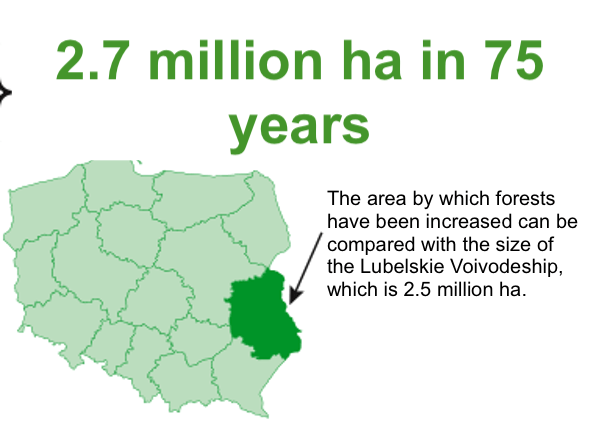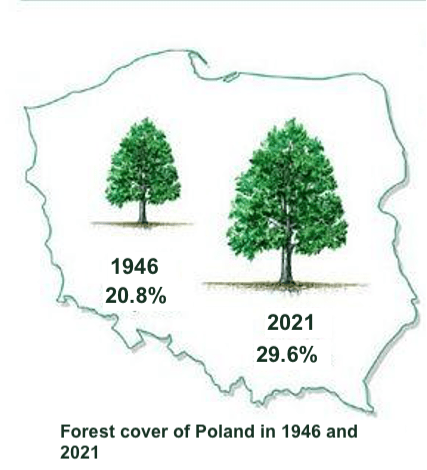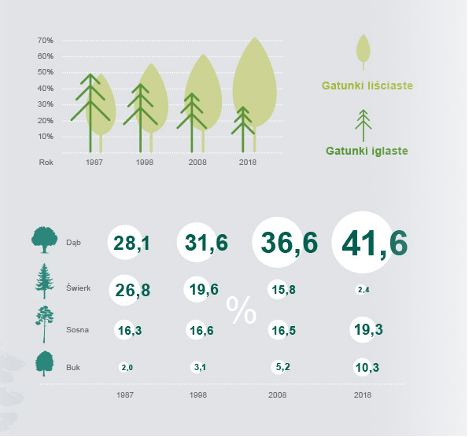We go to the forest for berries and mushrooms, and to the forester for wood. But where to find out how many forests grow in Poland and how to assess their quality? Is there a way to describe the forest in numbers?
It turns out that there is. In forestry, or more generally, the science related to the functioning of the forest, there are several parameters by which it is possible to determine in what shape the forests in our country are. These are forest cover, abundance, age, and species composition. What is hidden under these terms?
Forests cover 30% of the country
Forest cover is nothing more than an indicator of how much of a certain area is covered by forest. It is given as a percentage, which represents the ratio of the area covered by forests to the total area of a given area. Currently, Poland’s forest cover is 29.6 per cent, which means that forests cover almost a third of the country. This was not always the case. In 1946, the ratio was only 20.8 per cent. Thanks to the efforts of foresters, Poland’s forest cover has increased by almost half! No European country has such a leap in forest cover.
The Lubuskie Voivodeship has the highest forest cover (49.3 per cent), while the Łódzkie Voivodeship has the lowest (21.4 per cent).
A forest cover of 29.6 per cent corresponds to an area of 9.2 million hectares. This is the current size of Poland’s forest area. Since the end of the Second World War, Poland has added almost 2.7 million ha of forest. This is more than the area of the Lubelskie Voivodeship! Today, every third square kilometre of our country is covered by trees. And every year we have more and more forests in Poland. There will be even more. According to the “National Programme for Increasing Forest Cover”, a special programme developed by the Forestry Research Institute and approved for implementation by the Council of Ministers, Poland aims to increase Poland’s forest cover to 33% in 2050. About 65 per cent of plant, animal and fungal species live in them.


Wood resources amount to more than 2 billion cubic metres
Poland is one of the most wood-rich countries in the European Union. This is due to its location in a temperate climate zone, but also to a consistently pursued forestry policy. The wood harvested annually amounts to only around 2 per cent of what grows in the forests, which means that we are steadily increasing the abundance of Polish forests (i.e. the amount of wood per unit area, or simply the number and size of trees). The abundance is increasing in spite of the economic work carried out in the forests and the millions of cubic metres of timber that reaches Polish homes in various forms every year. It is three times higher today than it was at the end of the war!
Wood is the most natural and friendly material used on such a large scale. It is an indispensable part of today’s fashionable ‘eco’ lifestyle, in harmony with nature and in good health. In view of climate change, it is also important to note that it is not only living trees that bind significant amounts of carbon dioxide. Wood products are also a great store of CO2.
The more developed and modern the economy is, the more wood it needs. Over the last two decades, wood consumption in our country has increased as much as two and a half times. In 1990, a Pole consumed on average the equivalent of 0.4 cubic metres of round wood per year, while today this figure exceeds 1 cubic metre. It can be expected that this figure will rise even further – to values similar to those in other European countries (Germany consumes on average 1.7 cubic metres of wood per year, the Czech Republic almost 1.5 cubic metres, Italy 1.1 cubic metres).

The average age of a forest is as old as 60 years
Poland’s forests are becoming more and more stately and aged. Trees between 40 and 80 years of age are the most common. The average age of a forest is 60 years, but foresters are seeing a steadily increasing number of trees older than 80 years. Since the end of the Second World War, the area they cover has increased from 0.9 million ha to more than 2.3 million ha today. Tree stands over 100 years old occupy 14.9 per cent of the area in forests managed by the State Forests.
Already 32 per cent of deciduous trees
In lowland and upland areas, pine trees are the most common (around 60 per cent of the forest area), while spruce (in the west) and spruce with beech (in the east) predominate in the mountains. Pine dominates for a simple reason – forestry has been left with the worst quality soils, which pine tolerates. On fertile ones, our ancestors established arable fields. Such forests, however, proved to have little resistance to climatic factors. They also fell easy prey to pest attacks. Therefore, the presence of more resistant deciduous species: oaks, maples, beeches and lime trees is steadily increasing in Polish forests. Shortly after the Second World War, there was 13 per cent of them. Today, deciduous tree stands cover almost 32 per cent of the area.

More and more areas under special protection
Areas, managed by State Forests, are covered by various forms of nature protection. In 2011, there were 1,255 nature reserves in the areas managed by the State Forests, with a total area of 124,556 ha. In 2021, this number will increase to 1,289, translating into an overall increase of 250 ha. There are also ca. 11,000 nature monuments or 3,990 species protection zones.
Forests for everyone in just an hour
When writing about forest statistics, it is worth recalling that foresters have taken care of the comfort of staying in green areas. The forest fulfils an extremely important function for society. Poles have the opportunity to commune with nature and spend their free time in nature. It takes just one hour to reach a forest from any place in Poland!
Forestry statistics in this respect are equally impressive! Foresters have put at the disposal of the public and maintain more than 20,000 km of hiking trails, almost 4,000 km of bicycle trails, around 3,200 forest car parks and resting places and more than 600 camping areas and campsites. It is also the free educational offer of the State Forests – more than 1,000 didactic paths, nearly 600 educational shelters and more than 300 educational chambers and forest education centres.

